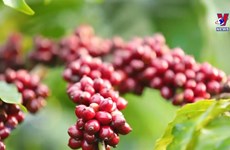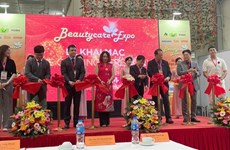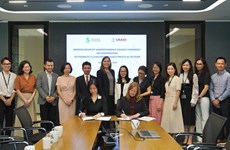Fisheries sector reaches out to ocean to develop marine economy
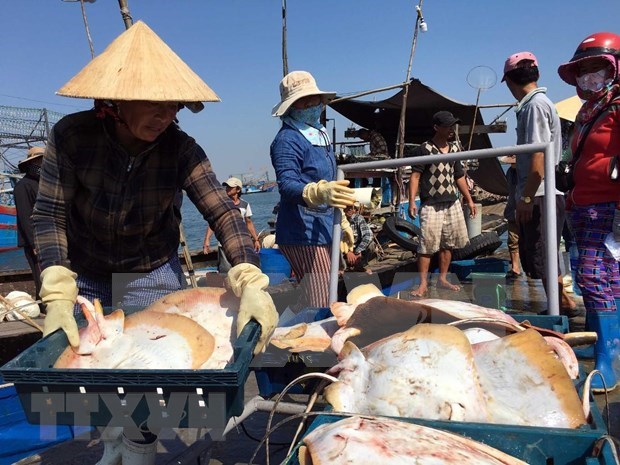 Through the supply chain, the quality of raw materials brought to the factory and processing area has been significantly improved (Photo: VNA)
Through the supply chain, the quality of raw materials brought to the factory and processing area has been significantly improved (Photo: VNA)Hanoi (VNA) - Vietnam has a coastline of 3,260km along the Northern-Central-Southern regions with abundant resource reserves - a great advantage in developing the marine economy.
In the past 20 years, thanks to strong restructuring, the fisheries industry has made great progress and become a key economic sector.
In particular, in his closing ceremony of the eighth session of the 12th Party Central Committee, General Secretary Nguyen Phu Trong laid stress on the Marine Economic Strategy, aiming that the sea-based economy will contribute 10% to the national GDP and the contribution of gross regional domestic product (GRDP) of coastal provinces and cities accounted for 65% -70% of the national GDP by 2030.
This Resolution is considered as an important orientation to create a new breakthrough for agriculture in general and the fisheries sector in particular in the Sea-based Economic Development Strategy.
Exploiting resources from the seabed
According to a report by the Ministry of Agriculture and Rural Development, seafood export turnover has increased by an average of nearly 15 percent per year, from a low of 550 million USD in 1995 to 9 billion USD in 2018.
Nguyen Hoai Nam, Vice President of Vietnam Association of Seafood Exporters and Producers (VASEP), said that in 2018, most of the seafood items saw strong growth. In particular, shrimp brought home about 3.58 billion USD, pangasius 2.26 billion USD; seafood groups of tuna, 675 million USD, mollusk, 785 million USD...
With its current position, Vietnam is in the top 5 countries supplying seafood in the world and quality products such as shrimp, catfish, tuna have been present in the most demanding markets such as the US, EU, Japan ...
As for pangasius, Mr. Nguyen Hoai Nam said this is a key product. Therefore, in recent years, many businesses have been very active in promoting and introducing to customers as well as import partners in order to increase the added value of the product.
As for tuna, in 2018, many processed products such as canned and instant tuna ... have been ordered more by international customers.
"This shows that the trend of value-added goods is an advantage for Vietnam," said VASEP Vice President.
Along with the implementation of marine economic development, the seafood industry also pays more attention to the linkage in the value chain, in order to strictly control the quality of the products.
Mr. Tran Dinh Luan, Deputy Director General of the General Directorate of Fisheries, said that in the restructuring plan of the sector, the reorganization of production and linkage is one of the focused and prioritized solutions.
For example, in three provinces such as Soc Trang, Bac Lieu and Ca Mau, shrimp products has shown a close chain, from the supply of input materials, to processing plants and traceability of the product.
In addition, for pangasius products, the close loop model from breeding areas to farming areas and processing plants has also been replicated.
Similar to fishing, currently, production and processing groups on the sea have been formed, the number of logistics and shipping vessels has increased. With farming products, the raw materials supplied for the factories also ensure the quality, quantity and specifications.
"This fact shows that, through the chain, the quality of raw materials brought to the factory and processing area has been significantly improved," Luan said.
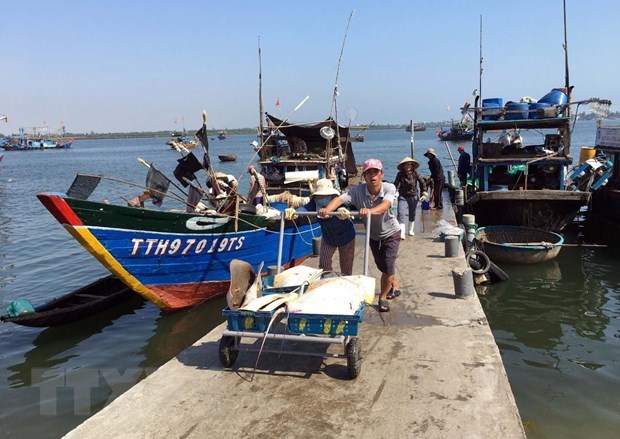 Marine economy has created momentum for the development of many other industries, such as fishing, aquaculture ... (Photo: VNA)
Marine economy has created momentum for the development of many other industries, such as fishing, aquaculture ... (Photo: VNA)
Specialized processing, raising added value
It can be clearly seen that the development of the marine economy has created momentum for the development of many other industries.
The total aquaculture area in 2018 is estimated at 1.3 million hectares, equaling 106% over the same period in 2017, the expected aquaculture production is 4.3 million tons, up 8.3%. 2018 also recorded a remarkable growth in the field. The area of farming pangasius reached 5,400 hectares, the output reached 1.42 million tons, up 8.4% compared to 2017.
However, climate change poses a looming situation. These includes drought, natural disasters and saline intrusion, have significantly affected Vietnam's fishing and aquaculture production.
Meanwhile, according to Truong Minh Hoang, Deputy Head of the National Assembly delegation of Ca Mau province, overfishing has led to the depletion of reserves thus affecting the livelihood of many fishermen.
Given this situation, he said that the State should have a plan for the fishing area and fishing time as well as introduce regulations on fishing gear, avoiding the destruction of marine resources at sea.
 By the end of 2018, there were an estimated 2,445 establishments producing brackish shrimp seeds, including 1,855 establishments producing tiger shrimp (Photo: VNA)
By the end of 2018, there were an estimated 2,445 establishments producing brackish shrimp seeds, including 1,855 establishments producing tiger shrimp (Photo: VNA)
Promoting advantages for sea benefits
Currently, Vietnam has signed and participated in many free trade agreements, but the signs of market protection are posing many challenges for Vietnam's seafood industry.
Nguyen Hoai Nam, Vice President of VASEP, said that in the past 10 years, the strict requirements on food quality and safety control from importing countries have required enterprises to constantly invest as well as strictly control products, as only a small negligence can entail unpredictable effects.
"If we meet the stringent standards of the importing country, it also means that the competitiveness of Vietnamese products continues to be raised," the VASEP representative added.
Meanwhile, Mr. Tran Dinh Luan, Deputy Director of the Directorate of Fisheries, noted that in order to ensure the products uniform in quality, as well as supply enough raw materials for export processing, linkage between production areas is essential to promote the application of science and technology and to better perform traceability.
According to Mr. Luan, the fisheries sector is focusing on science and technology to make the best use of available raw materials, as well as processing value-added products.
According to experts, because the method of marine farming is still in small scale, the level of production is low, Vietnam has not yet fully exploited the potential aquatic resources despite great potential.
Mr. Nguyen Huu Dung, Chairman of Vietnam Marine Farming Association proposed, in the field of industrial marine farming, production organizations "must head out to the ocean to reach the ocean, cope with storms as well as overcome challenges to cultivate the sea."/.










